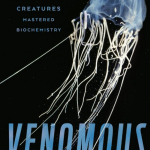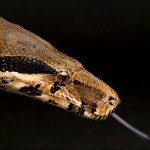Snakes
You can read this book review, or you can just go HERE and listen to our interview with author Christie Wilcox. I promise you in advance that you will want to read her book!
But, if you want to read the book review, here it is...
Did you ever do anything that hurt, then you had to do it again and you knew it would still hurt, and you didn't like that? Like getting your teeth cleaned, or licking a nine volt battery. OK, maybe you didn't have to lick the nine volt battery, but you get my point.
When I was working in the Ituri Forest, in the Congo, taking a walk in the forest was one of…
Guest post by Hillary Craddock
Last week a new study regarding Eastern Equine Encephalitis (EEE) was published online (Bingham et.al.). EEE is a mosquito-borne virus that can cause serious, and sometimes deadly, disease in humans and equines. In warmer parts of North America, the virus is spread year-round, but in areas where mosquitoes get killed off in the winter it has been something of a mystery as to how the virus makes it from year to year. Humans and equines are both dead-end hosts, which means that a mosquito can not be infected from biting an infected person or horse. Researchers in…
Image from: National Geographic, photograph by Joel Sartore
In 2009, scientists at the California Academy of Sciences Steinhart Aquarium discovered some of the snakes suffering from a strange illness that caused them to stare off into space, appear like they were drunk and even tie themselves into knots they could not escape. Other serious symptoms included the buildup of proteins, susceptibility to secondary bacterial infections and body wasting. This mysterious illness posed a big problem for captive snakes like boa constrictors and pythons because it…
Today, I took out the trash. I may or may not have taken the trash out last week, but I can tell you that the last time I did take it out, whenever it was, I had to drag the trash barrel across ice. Yesterday I went to the gym without a coat or jacket. That made me have to decide if I wanted to go to the locker room to stow the contents of my pockets (car keys, etc.) or just keep those things in my pocket. The grass outside is green. We expect snow on Friday.
Where I grew up, in what is now known among gardeners and cooperative extension agents as Zone 5b (though a short drive from a…
This past weekend, I was searching around the interwebz looking for something interesting to write about for Monday Pets. Lately, Monday Pets has been somewhat cat- and dog-heavy, so I was looking for something a bit different. I asked on twitter if there were any requests or recommendations. Friend of the blog Dave Munger responded: "What about snakes?"
What about snakes indeed? There are many parallels between myself and Indiana Jones, but one big one is that we both hate snakes. Another similarity is whenever I travel by plane, I leave a series of red dashes to mark my path. We both look…
Dr. Free-Ride: So, you know how sometimes you have nightmares?
Younger Offspring: Yeah.
Dr. Free-Ride: I had a nightmare the other night.*
Younger Offspring: What was it?
Dr. Free-Ride: Well, I was supposed to be picking up snakes with two sticks and moving them from one place to another.
Younger Offspring: Why?
Dr. Free-Ride: I don't know why. It was one of those dreams where, in the middle of it, you really don't know why it is like it is, but you just go with it. But anyway, it was fine until I realized that one of the snakes that I had to pick up was a cobra.
Younger Offspring: Yikes!…
Take a whiff of mustard or wasabi and you'll be hit with a familiar burning sensation. That's the result of chemicals in these pungent foods hitting a protein called TRPA1, a molecular alarm that warns us about irritating substances. The same protein does a similar job in other animals, but rattlesnakes and vipers have put their version of TRPA1 to a more impressive and murderous purpose. They use it to sense the body heat of their prey.
Pit vipers are famed for their ability to detect the infrared radiation given off by warm-blooded prey, and none more so than the western diamondback…
Snakes have been around for nearly 100 million years and scientists have found many fossils of extinct species. But this astonishing specimen is different. This serpent is Sanajeh indicus. It is sitting in a dinosaur nest and its coils surround three eggs and the body of a hatchling.
There are many reasons to think that this prehistoric tableau represented a predator caught in the act of hunting, rather than a mash-up of unconnected players thrown together by chance. The snake is perfectly posed, with its head resting atop a coil and its body encircling a crushed egg. All the pieces are…
tags: Woodpecker vs Snake, behavior, birds, Giant Bird Snake, Pseustes sulphureus, Crimson-crested Woodpecker, Campephilus melanoleucos, streaming video
Here is some remarkable footage from somewhere in the Amazon (Peru?) of a Crimson-crested Woodpecker, Campephilus melanoleucos, taking on a "Giant bird snake" or "puffing snake", Pseustes sulphureus, that has raided its nest and swallowed its eggs.
Tiger snakes are a group of extremely venomous serpents found all over the southern half of Australia, and on many of its islands. Some were cut off from the mainland by rising sea levels more than 9,000 years ago, while others were inadvertently introduced by travelling humans and have been around for less than 30 years.
When the snakes first arrive on an island, they find prey that are generally larger than they're used to on the mainland. That puts them under strong evolutionary pressure to have larger heads, in order to swallow larger meals. But by feeding snakes from different…
It seems like an uneven match. In one corner, the unassuming California ground squirrel (Spermophilus beechyi), 30cm in length. In the other, the northern Pacific rattlesnake (Crotalus oreganos), more than twice the length of the squirrel, and armed with hinged fangs that pack a lethal venom. But thanks to a cunning adaptation, the squirrel often gets an unexpected upper hand in this bout.
Ground squirrels live in a series of burrows that keep them out of reach of most predators. Snakes, however, have exactly the right body plan for infiltrating long sinuous tunnels, and it's not surprising…
Underwater, fish make very difficult prey. When they sense sudden disturbances in the water around them, they respond within five thousandths of a second with a defensive reflex called the C-start. Their body contorts into a C-shape and with a flick of the tail, they rapidly zoom away from the potential threat. But one predator has a way of turning the fish's defence against it, persuading the fish to swim towards danger. It's the tentacled snake.
The tentacled snake (Erpeton tentaculatum) is a bizarre species, easily recognised by the pair of short "tentacles" on the front of its…
This is sure to be one of the most amazing scientific images of the year. You're looking at vertebrae from two species of snake. The smaller model on the left belongs to the anaconda, a giant serpent that can grow to 7 metres in length and weigh as much as 45kg. It's arguably the largest snake alive, so just think about how big the owner of the fossilised vertebra on the right would have been! There's a good reason why this new discovery - the largest snake that ever slithered - has been named Titanoboa.
Titanoboa cerrejonesis is new to science and was discovered by a team of North…
Many animals use poisonous secretions to protect themselves from predators. But poisons are complex chemicals and can take a lot of energy to make. Why invest in them, when you can steal someone else's?
Poison thieves are well-known in the animal kingdom. Many species of brightly coloured poison arrow frogs acquire their poisons from beetles, while some sea slugs make a living by hunting for jellyfish, transporting their stinging cells into their own limbs. Now, another species joins this guild of thieves - the tiger keelback snake, Rhabdophis tigrinis (image right, by Deborah…
tags: Mean and Lowly Things, herpetology, reptiles, venomous snakes, amphibians, field research, Congo Brazzaville, Kate Jackson, book review
Are you familiar with the aphorism, "Do what you love and the money will follow"? Well, the money part of that equation is probably questionable, but I think you will be convinced that a person who pursues her passions will never live a boring life, especially after you've finished reading Kate Jackson's book, Mean and Lowly Things: Snakes, Science, and Survival in the Congo (Cambridge, Massachusetts: Harvard University Press; 2008). This book tells the…
The era of genetic sequencing has revealed as much about the ties that bind us to other animals as the differences that set us apart. Often, comparing the genomes of different species shows that large changes in body size, shape and form are not mirrored by similar changes at a genetic level. New adaptations typically come about through small changes that redeploy existing genes to different ends, rather than raw innovation.
Snakes are an exception. A new study by Todd Castoe and Zhi Jiang at the University of Colorado has shown that the lifestyle of serpents is so unique that some…
Yesterday morning I was sitting at conference table, downing coffee to keep my eyes open, when I heard someone say that it's springtime now and the snakes are waking up. Well, those kinds of statements at the breakfast table do have a way of getting my attention.
I turned sideways and realized the words were coming from a high school science teacher, that I know, from Arizona.
"Snakes hibernate?"
"Sure," she said, "and people who move here in the winter time are pretty surprised when a snake wakes up and crawls out from under their porch."
A few other questions and everyone at the table…
The story of evolution is filled with antagonists, be they predators and prey, hosts and parasites, or males and females. These conflicts of interest provide the fuel for 'evolutionary arms races' - cycles of adaptation and counter-adaptation where any advantage gained by one side is rapidly neutralised by a counter-measure from the other. As the Red Queen of Lewis Carroll's Through the Looking Glass said to Alice, "It takes all the running you can do, to keep in the same place."
The Red Queen analogy paints a picture of natural foes, wielding perfectly balanced armaments and caught in a…
tags: researchblogging.org, evolution, squirrels, rattlesnakes, tail-flagging, behavior, biology
A mother squirrel rapidly waves her tail to warn off a rattlesnake in a confrontation staged by researchers in May 1987. Adult squirrels are immune to rattlesnake venom, but their offspring are vulnerable. New infrared research found that heat from the mother's tail sends an alarming signal to the slithery predators.
Image: Donald H. Owings, UC Davis.
Researchers have long been mystified by the defensive behaviors exhibited by California ground squirrels, Spermophilus beecheyi, when they are…


